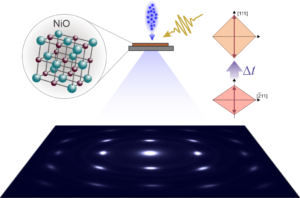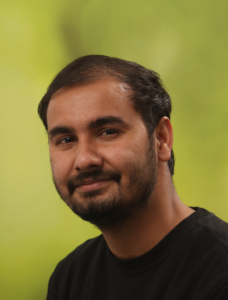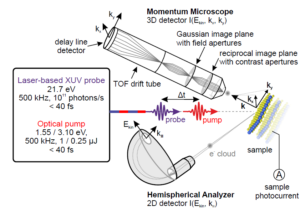Home
Welcome to the Dynamics of Correlated Materials group!
We are an experimental research group focusing on the investigation of ultrafast processes in strongly correlated materials. Our goal is the understanding of the fundamental interactions at play on the microscopic level in such materials, leading to complex behavior. We develop and employ complementary ultrafast techniques such as time- and angle-resolved photoelectron spectroscopy (trARPES) and time-resolved diffraction techniques to study those elementary interaction processes and couplings across ultrafast phase transitions.
News
A link between exchange striction and nonthermal Lattice Dynamics
Apr 2021

Our recent study of ultrafast lattice dynamics in NiO has demonstrated the existance of a nonthermal phonon population, and that this is directly linked to change in the antiferromagnetically-induced lattice distortion, known as “exchange striction”. The study was enabled by combining unique capabilities of two institutions: growth of a 20nm-thick free-standing NiO single crystal at the university of Halle, and state-of-the-art femtosecond electron diffraction at the Fritz Haber Instititue. The study open a new avenue towards ultrafast control of antiferromagnets via the crystal lattice.
Windsor et al, Phys. Rev. Lett. 126, 147202 (2021)
Windsor et al, Phys. Rev. Lett. 126, 147202 (2021)
New preprint: Bloch Wavefunction Reconstruction using Multidimensional Photoemission Spectroscopy
Mar 2021

The most advanced experimental technique to measure the electronic band structure of solids is angle-resolved photoemission spectroscopy (ARPES). While ARPES directly maps the momentum-resolved electronic eigenvalues (energy bands), topological properties are often hidden in the complex-valued Bloch wavefunction, which is not directly accessible in standard photoemission experiments. In a recent joint experimental and theoretical work in collaboration with Dr. Michael Schüler and Prof. Thomas Devereaux from Stanford University, we have found a novel approach to reconstruct the Bloch wavefunction of WSe2 from polarization-modulated ARPES, with minimal theory input (arXiv:2103.17168).
New group member: Ashutosh Rathi
Jan 2021

We are happy to welcome our new Postdoc Ashutosh Rathi to the group!
A quantitative comparison of time-of-flight momentum microscopes and hemispherical analyzers for time-resolved ARPES experiments
Dec 2020

Recent advancements in time-of-flight-based momentum microscope development have led to a growing presence of this novel detection scheme in photoemission studies, as it enables highly parallelized and simultaneous acquisition of the full 3-dimensional momentum- and energy-resolved photoelectron distribution. Combining such instruments with modern high-repetition-rate extreme ultraviolet (XUV) laser sources for ultrafast pump-probe photoemission experiments seems like an ideal match, and is followed by several groups worldwide. However, particularly important for time-resolved studies, several factors such as space-charge effects need to be considered and depend on the chosen analyzer type.
In our study (Rev. Sci. Instr. 91, 123112 (2020)) we present a first benchmark comparison of the momentum microscope and the current standard [more...]
In our study (Rev. Sci. Instr. 91, 123112 (2020)) we present a first benchmark comparison of the momentum microscope and the current standard [more...]
An open-source, end-to-end workflow for multidimensional photoemission spectroscopy
Dec 2020

In our recent publication (R.P. Xian, et al., Scientific Data, 7, 442 (2020)) we present a flexible, open-source workflow for handling of single-event multidimensional photemission data. Based on a parallelized python code package, efficient data binning and conversion, as well as multidimensional coordinate transformation and calibration is provided. Our efforts aim at establishing a generic multi-purpose code platform for multidimensional photoemission spectroscopy data.